Reading time: 15 min
There was once a man, whose wife was dead, and a woman, whose husband was dead; and the man had a daughter, and so had the woman. The girls were acquainted with each other, and used to play together sometimes in the woman’s house. So the woman said to the man’s daughter, „Listen to me, tell your father that I will marry him, and then you shall have milk to wash in every morning and wine to drink, and my daughter shall have water to wash in and water to drink.“ The girl went home and told her father what the woman had said.
The man said, „What shall I do! Marriage is a joy, and also a torment.“ At last, as he could come to no conclusion, he took off his boot, and said to his daughter, „Take this boot, it has a hole in the sole. Go up with it into the loft, hang it on the big nail and pour water in it. If it holds water, I will once more take to me a wife. If it lets out the water, so will I not.“ The girl did as she was told, but the water held the hole together, and the boot was full up to the top. So she went and told her father how it was.
And he went up to see with his own eyes, and as there was no mistake about it, he went to the widow and courted her, and then they had the wedding. The next morning, when the two girls awoke, there stood by the bedside of the man’s daughter milk to wash in and wine to drink, and by the bedside of the woman’s daughter there stood water to wash in and water to drink. On the second morning there stood water to wash in and water to drink for both of them alike.
On the third morning there stood water to wash in and water to drink for the man’s daughter, and milk to wash in and wine to drink for the woman’s daughter; and so it remained ever after. The woman hated her stepdaughter, and never knew how to treat her badly enough from one day to another. And she was jealous because her stepdaughter was pleasant and pretty, and her real daughter was ugly and hateful. Once in winter, when it was freezing hard, and snow lay deep on hill and valley, the woman made a frock out of paper, called her stepdaughter, and said, „Here, put on this frock, go out into the wood and fetch me a basket of strawberries. I have a great wish for some.“
„Oh dear,“ said the girl, „there are no strawberries to be found in winter. The ground is frozen, and the snow covers everything. And why should I go in the paper frock? it is so cold out of doors that one’s breath is frozen. The wind will blow through it, and the thorns will tear it off my back!“ – „How dare you contradict me!“ cried the stepmother, „be off, and don’t let me see you again till you bring me a basket of strawberries.“
Then she gave her a little piece of hard bread, and said, „That will do for you to eat during the day,“ and she thought to herself, „She is sure to be frozen or starved to death out of doors, and I shall never set eyes on her again.“ So the girl went obediently, put on the paper frock, and started out with the basket. The snow was lying everywhere, far and wide, and there was not a blade of green to be seen. When she entered the wood she saw a little house with three little men peeping out of it.
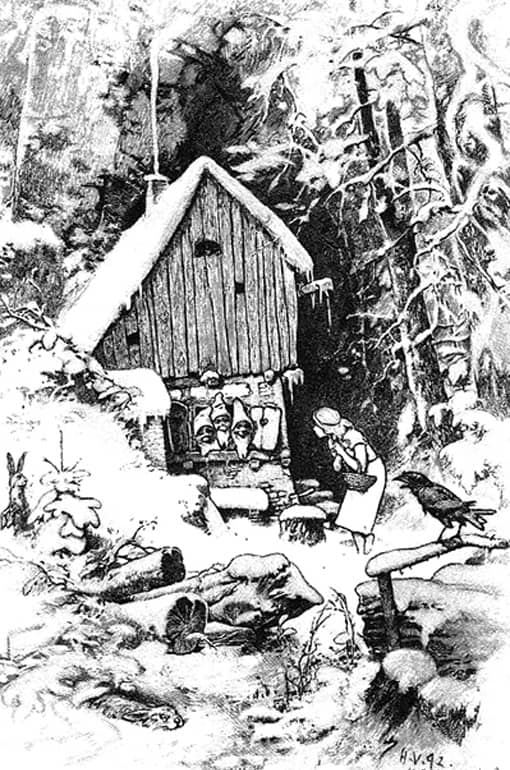
She wished them good day, and knocked modestly at the door. They called her in, and she came into the room and sat down by the side of the oven to warm herself and eat her breakfast. The little men said, „Give us some of it.“ – „Willingly,“ answered she, breaking her little piece of bread in two, and giving them half. They then said, „What are you doing here in the wood this winter time in your little thin frock?“
„Oh,“ answered she, „I have to get a basket of strawberries, and I must not go home without them.“ When she had eaten her bread they gave her a broom, and told her to go and sweep the snow away from the back door. When she had gone outside to do it the little men talked among themselves about what they should do for her, as she was so good and pretty, and had shared her bread with them. Then the first one said, „She shall grow prettier every day.“ The second said, „Each time she speaks a piece of gold shall fall from her mouth.“ The third said, „A king shall come and take her for his wife.“
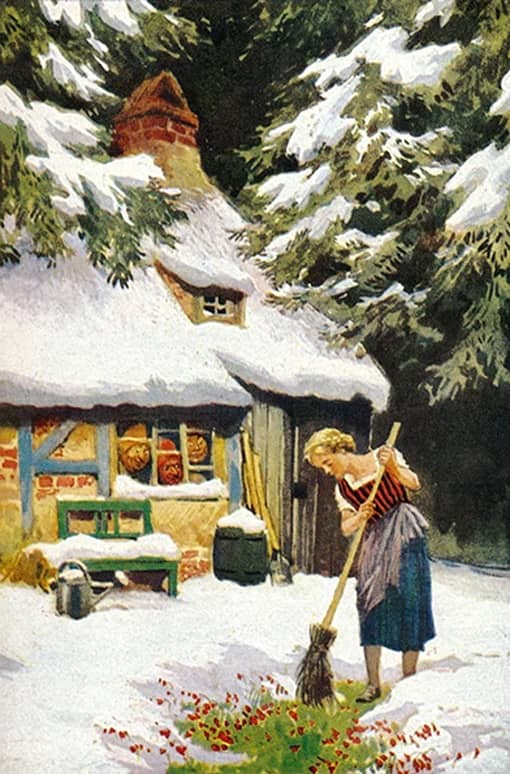
In the meanwhile the girl was doing as the little men had told her, and had cleared the snow from the back of the little house, and what do you suppose she found? fine ripe strawberries, showing dark red against the snow! Then she joyfully filled her little basket full, thanked the little men, shook hands with them all, and ran home in haste to bring her stepmother the thing she longed for. As she went in and said, „Good evening,“ a piece of gold fell from her mouth at once. Then she related all that had happened to her in the wood, and at each word that she spoke gold pieces fell out of her mouth, so that soon they were scattered all over the room.
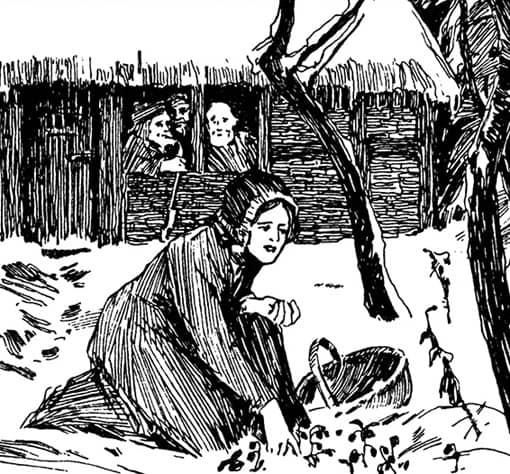
„Just look at her pride and conceit!“ cried the stepsister, „throwing money about in this way!“ but in her heart she was jealous because of it, and wanted to go too into the wood to fetch strawberries. But the mother said, „No, my dear little daughter, it is too cold, you will be frozen to death.“ But she left her no peace, so at last the mother gave in, got her a splendid fur coat to put on, and gave her bread and butter and cakes to eat on the way.
The girl went into the wood and walked straight up to the little house. The three little men peeped out again, but she gave them no greeting, and without looking round or taking any notice of them she came stumping into the room, sat herself down by the oven, and began to eat her bread and butter and cakes. „Give us some of that,“ cried the little men, but she answered, „I’ve not enough for myself. How can I give away any?“ Now when she had done with her eating, they said, „Here is a broom, go and sweep all clean by the back door.“
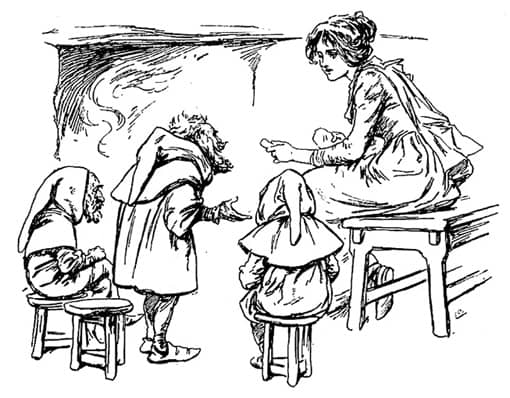
„Oh, go and do it yourselves,“ answered she. „I am not your housemaid.“ But when she saw that they were not going to give her anything, she went out to the door. Then the three little men said among themselves, „What shall we do to her, because she is so unpleasant, and has such a wicked jealous heart, grudging everybody everything?“ The first said, „She shall grow uglier every day.“ The second said, „Each time she speaks a toad shall jump out of her mouth at every word.“ The third said, „She shall die a miserable death.“
The girl was looking outside for strawberries, but as she found none, she went sulkily home. And directly she opened her mouth to tell her mother what had happened to her in the wood a toad sprang out of her mouth at each word, so that every one who came near her was quite disgusted. The stepmother became more and more set against the man’s daughter, whose beauty increased day by day, and her only thought was how to do her some injury. So at last she took a kettle, set it on the fire, and scalded some yarn in it.
When it was ready she hung it over the poor girl’s shoulder, and gave her an axe, and she was to go to the frozen river and break a hole in the ice, and there to rinse the yarn. She obeyed, and went and hewed a hole in the ice, and as she was about it there came by a splendid coach, in which the King sat. The coach stood still, and the King said, „My child, who art thou, and what art thou doing there?“ She answered, „I am a poor girl, and am rinsing yarn.“ Then the King felt pity for her, and as he saw that she was very beautiful, he said, „Will you go with me?“
„Oh yes, with all my heart,“ answered she. And she felt very glad to be out of the way of her mother and sister. So she stepped into the coach and went off with the King; and when they reached his castle the wedding was celebrated with great splendour, as the little men in the wood had foretold. At the end of a year the young Queen had a son. And as the stepmother had heard of her great good fortune she came with her daughter to the castle, as if merely to pay the King and Queen a visit.
One day, when the King had gone out, and when nobody was about, the bad woman took the Queen by the head, and her daughter took her by the heels, and dragged her out of bed, and threw her out of the window into a stream that flowed beneath it. Then the old woman put her ugly daughter in the bed, and covered her up to her chin. When the King came back, and wanted to talk to his wife a little, the old woman cried, „Stop, stop! she is sleeping nicely. She must be kept quiet to day.“
The King dreamt of nothing wrong, and came again the next morning. And as he spoke to his wife, and she answered him, there jumped each time out of her mouth a toad instead of the piece of gold as heretofore. Then he asked why that should be, and the old woman said it was because of her great weakness, and that it would pass away. But in the night, the boy who slept in the kitchen saw how something in the likeness of a duck swam up the gutter, and said, „My King, what mak’st thou? Sleepest thou, or wak’st thou?“ But there was no answer. Then it said,
„What cheer my two guests keep they?“ So the kitchen-boy answered, „In bed all soundly sleep they.“ It asked again, „And my little baby, how does he?“ And he answered, „He sleeps in his cradle quietly.“ Then the duck took the shape of the Queen and went to the child, and gave him to drink, smoothed his little bed, covered him up again, and then, in the likeness of a duck, swam back down the gutter. In this way she came two nights, and on the third she said to the kitchen-boy, „Go and tell the King to brandish his sword three times over me on the threshold!“
Then the kitchen-boy ran and told the King, and he came with his sword and brandished it three times over the duck, and at the third time his wife stood before him living, and hearty, and sound, as she had been before. The King was greatly rejoiced, but he hid the Queen in a chamber until the Sunday came when the child was to be baptized. And after the baptism he said, „What does that person deserve who drags another out of; bed and throws him in the water?“
And the old woman answered, „No better than to be put into a cask with iron nails in it, and to be rolled in it down the hill into the water.“ Then said the King, „You have spoken your own sentence“, and he ordered a cask to be fetched, and the old woman and her daughter were put into it, and the top hammered down, and the cask was rolled down the hill into the river.
 Learn languages. Double-tap on a word.Learn languages in context with Childstories.org and Deepl.com.
Learn languages. Double-tap on a word.Learn languages in context with Childstories.org and Deepl.com.Backgrounds
Interpretations
Adaptions
Summary
Abstract
Linguistics
„The Three Little Men in the Wood“ is a lesser-known fairy tale from the Brothers Grimm, collected in their 1812 publication „Children’s and Household Tales“ (also known as „Grimm’s Fairy Tales“). This story, like many others in the Grimm collection, is deeply rooted in European folklore and oral tradition.
The tale follows a young girl who, after the death of her mother, is mistreated by her cruel stepmother and stepsister. One day, the girl is sent into the cold woods to gather strawberries, despite the snow. There, she meets three magical little men living in a small house. The girl’s kindness and generosity towards the little men lead them to grant her three wishes: beauty, wealth, and a long and happy life. The stepmother, upon hearing of the girl’s good fortune, sends her own daughter into the woods with the hope of gaining the same blessings. However, the stepsister’s selfishness and rudeness result in a series of terrible punishments.
The story of „The Three Little Men in the Wood“ shares common themes and motifs with many other European fairy tales. These include the magical number three, the concept of supernatural beings rewarding or punishing characters based on their behavior, the wicked stepmother and stepsister, and the eventual triumph of goodness and kindness over evil and selfishness.
The Brothers Grimm collected this story, along with many others, as part of their larger project to document and preserve German folklore and oral traditions. Their work was part of the broader Romantic movement in 19th-century Europe, which emphasized a return to traditional folk culture and a celebration of national identity. Although the Brothers Grimm often made changes and edits to the stories they collected, their work remains an important resource for understanding the cultural and historical context of European fairy tales.
„The Three Little Men in the Wood“ is categorized as Aarne-Thompson-Uther (ATU) type 403B and type 480, „The Kind and the Unkind Girls,“ which is a classification system for folktale types. This type of tale involves two girls (usually sisters or stepsisters), one kind and the other unkind, who each encounter magical beings. The kind girl’s good behavior is rewarded, while the unkind girl’s bad behavior results in punishment.
Fairy tales like „The Three Little Men in the Wood“ were primarily oral stories passed down through generations before they were written and collected by folklorists like the Brothers Grimm. These tales served various purposes, such as providing entertainment, teaching moral lessons, and reflecting the social values and concerns of the time. The themes and motifs found in „The Three Little Men in the Wood“ have been adapted and reinterpreted in various forms throughout history, including literature, theater, and film.
„The Three Little Men in the Wood,“ like many other fairy tales, can be interpreted in various ways. Here are some common interpretations of the story.
Moral lessons: The story emphasizes the importance of virtues such as kindness, generosity, and humility. The protagonist’s good deeds are rewarded, while the selfish and rude behavior of her stepsister leads to punishment. This tale serves as a reminder that our actions have consequences, and that treating others with kindness and respect can bring about positive outcomes.
The power of inner beauty: The protagonist’s genuine kindness and selflessness are contrasted with her stepsister’s superficial beauty and selfishness. This contrast highlights the importance of inner beauty and the idea that a person’s character is more important than their physical appearance.
Kindness and generosity: The story demonstrates the importance of treating others with kindness and sharing what one has. The stepdaughter’s willingness to share her bread with the little men leads to blessings and a better life, while her stepsister’s selfishness and rudeness result in curses and an unhappy fate.
Family dynamics: The tale highlights the difficulties that can arise in blended families, particularly with stepmothers and stepsiblings. The stepmother’s favoritism towards her biological daughter and mistreatment of her stepdaughter reflect the struggles that can occur when families merge. It serves as a cautionary tale to treat all family members fairly and with love.
Jealousy: The story explores the destructive nature of jealousy. The stepsister’s envy of her step-sibling’s good fortune leads her to seek out the little men in the woods, but her bitter and selfish attitude ultimately results in her own suffering. This theme emphasizes the importance of overcoming jealousy and embracing the well-being of others.
Consequences of one’s actions: The tale illustrates the idea that actions have consequences, both good and bad. The stepdaughter’s kind behavior is rewarded with blessings, while her stepsister and stepmother’s wicked actions lead to their own demise. This message reinforces the notion that one’s choices and behavior can significantly impact their life and the lives of those around them.
The transformative power of magic: The three little men in the wood act as agents of transformation in the story. They have the power to grant wishes and change the characters‘ lives based on their actions. This magical intervention can be seen as a metaphor for the potential for growth and change that exists within everyone, especially when they choose to act with kindness and generosity.
Social commentary: The tale may also be read as a critique of the social conditions of the time. The story highlights the plight of the poor and the vulnerable (in this case, the young girl who has lost her father and is mistreated by her stepfamily). The eventual triumph of the protagonist can be seen as a form of social justice, with the magical intervention of the three little men serving as a catalyst for change.
The role of women: The story presents two contrasting images of femininity: the kind and gentle protagonist and her cruel and selfish stepsister. By rewarding the protagonist and punishing the stepsister, the tale may be reinforcing traditional gender roles and expectations, emphasizing the value of kindness, generosity, and humility in women.
The significance of the number three: The number three is a recurring motif in fairy tales and folklore. In „The Three Little Men in the Wood,“ the number three is associated with magic and the granting of wishes, signifying the power and importance of this number in the story’s structure and themes.
These are just a few of the possible interpretations of „The Three Little Men in the Wood.“ As with all fairy tales, individual readers may find different meanings and messages within the story based on their own experiences and perspectives. Overall, „The Three Little Men in the Wood“ teaches valuable lessons about the importance of kindness, fairness, overcoming jealousy, and understanding the consequences of one’s actions.
„The Three Little Men in the Wood“ is a German fairy tale collected by the Brothers Grimm, Jacob and Wilhelm, in their famous collection „Grimms‘ Fairy Tales“ (originally titled „Kinder- und Hausmärchen“). The Brothers Grimm were German scholars, linguists, and folklorists who collected and published numerous traditional European fairy tales during the early 19th century. Their collection, which was first published in 1812, includes well-known stories like „Cinderella,“ „Snow White,“ „Rapunzel,“ and „Hansel and Gretel,“ among many others. „The Three Little Men in the Wood“ has been adapted into various forms of media, including books, plays, and films. While „The Three Little Men in the Wood“ is not as well-known as some other Grimm fairy tales, it has inspired a number of adaptations and retellings over the years. Some examples include.
Films: „The Three Little Men“ (1953): This film adaptation, directed by Walter Janssen, is a German-language musical comedy that follows the basic storyline of the original fairy tale. „The Three Little Men in the Wood“ (1977): This animated adaptation, directed by Ivo Caprino, is a Norwegian-language film that follows the story of three little men who help a poor girl named Tova in the forest. „Sneewittchen und die drei kleinen Männer“ (2018): This German-language film adaptation, directed by Sinje Köhler, is a modern retelling of the original fairy tale that incorporates elements of fantasy and horror.
Television: „Simsala Grimm“ (1999-2010): A German animated series that retold various Grimm fairy tales, including „The Three Little Men in the Wood.“ The series often added unique twists to the stories, making them more accessible and engaging for younger audiences.
Books and retellings: „The Three Little Men in the Wood“ in „Grimm’s Fairy Tales“ by Philip Pullman (2012): In this retelling, Pullman stays true to the original story while adding his own commentary and insights on the tale’s themes and messages. „Little Men in the Wood: A Retelling of the Brothers Grimm’s The Three Little Men in the Wood“ by Eric A. Kimmel (1998): Kimmel adapts the story for young readers, simplifying the language and adding colorful illustrations to help bring the story to life. „Three Little Men in the Woods“ (1990): This children’s book, written and illustrated by Joanne Oppenheim, is a modern retelling of the original fairy tale.
Theater: „The Three Little Men in the Wood“ has been adapted as a stage play or puppet show by various theater groups and schools, primarily for children’s audiences. These adaptations often simplify the story and focus on the themes of kindness, generosity, and the importance of inner beauty. „The Three Little Men in the Wood“ (2016): This stage adaptation, written and directed by Lorraine McShane, is a British theater production that combines elements of dance and puppetry.
While not as widely adapted as some other Grimm fairy tales, „The Three Little Men in the Wood“ has found a place in the hearts of readers and audiences through these various adaptations. Its timeless themes and engaging story make it a captivating tale for children and adults alike. Overall, „The Three Little Men in the Wood“ has inspired a variety of creative adaptations that have brought new life to this classic fairy tale.
„The Three Little Men in the Wood“ is a Brothers Grimm fairy tale about a kind-hearted girl who encounters magical little men in the woods and receives blessings, while her stepsister suffers a different fate due to her selfishness and rudeness.
The story begins with a man who remarries after the death of his wife, bringing a new stepmother and stepsister into the life of his daughter. The stepmother is cruel and envious of the girl’s natural beauty, so she mistreats her and forces her to perform difficult tasks. One day, she sends the girl into the snow-covered woods to gather strawberries.
Despite the harsh conditions, the girl ventures into the woods and stumbles upon a small house inhabited by three little men. They welcome her in, and she kindly helps with their chores and shares her meager meal with them. Touched by her generosity, the little men grant her three wishes: beauty, wealth, and a long and happy life.
When the girl returns home, her stepmother is amazed by her transformation and decides to send her own daughter to the woods, hoping she will receive the same blessings. However, the stepsister is rude and selfish, refusing to help the little men or share her food with them. As a result, they curse her with ugliness, poverty, and a short, miserable life.
In the end, the kind-hearted girl lives a long and happy life, while the stepsister suffers the consequences of her selfish behavior. The story emphasizes the importance of kindness, generosity, and inner beauty, with the three little men acting as magical agents of reward and punishment.
„The Three Little Men in the Wood“ is a fairy tale by the Brothers Grimm about a man and a woman, both widowed, who marry each other, and their respective daughters. The woman treats her stepdaughter poorly and forces her to do difficult tasks. One winter day, the stepmother sends her stepdaughter into the woods to gather strawberries, wearing only a paper dress. The girl finds a house with three little men living in it. They ask her to share her bread, which she does, and they grant her three blessings: growing more beautiful every day, having a piece of gold fall from her mouth whenever she speaks, and eventually marrying a king.
When the girl returns home, her stepsister becomes jealous of her fortune and insists on going to the woods herself. The stepsister, however, is rude to the little men and is consequently cursed to grow uglier every day, have a toad jump from her mouth whenever she speaks, and die a miserable death.
Eventually, the stepdaughter marries the king and has a child. Her stepmother and stepsister visit the castle, and while the king is away, they throw the young queen into a river and replace her with the ugly stepsister. The true queen, in the form of a duck, returns to the castle for three nights, and on the third night, she instructs the kitchen-boy to have the king brandish his sword over her three times, which restores her to her human form.
After the child’s baptism, the king asks his wife’s stepmother what punishment would be fitting for someone who throws another person into the water. The stepmother unknowingly sentences herself and her daughter to be placed in a cask filled with nails and rolled down a hill into the river, thus sealing their own fate.
Linguistic analysis of the fairy tale „The Three Little Men in the Wood“ by the Brothers Grimm can be approached from various angles, such as syntax, semantics, pragmatics, and stylistic choices.
Here, I’ll explore several key aspects
Syntax and Structure: The story uses a mix of simple and compound sentences. The narrative often employs a paratactic structure, where clauses are placed one after another without subordinating conjunctions, reflecting a more oral storytelling tradition. Dialogue is frequent, often introduced with verbs like „said,“ „cried,“ „answered,“ and this dialogue helps to drive the plot forward and reveal character motivations.
Lexical Choices: The language is relatively simple and direct, suitable for a fairy tale audience, including children. It employs common vocabulary that is easy to understand, such as „stepmother,“ „strawberries,“ „king,“ „queen,“ „gold,“ and „toad. “
– Descriptive language is used sparingly but effectively to set scenes and describe characters, such as „pleasant and pretty,“ „ugly and hateful,“ and „splendid coach. “
Semantic Features: Motifs like transformation (e. g. , the Queen turning into a duck), trials (fetching strawberries in winter), and rewards/punishments (growing prettier vs. uglier, gold vs. toads) are central to the narrative structure. The tale explores themes of jealousy, kindness, justice, and reward through its characters and their interactions.
Pragmatics: The communication between characters often includes indirect requests and commands, particularly in dialogues between the stepmother and stepdaughter, veiled by the social norms and power dynamics of the fairy tale world. The use of reported speech, especially concerning the little men’s blessings and curses, enhances the magical and moral dimensions of the story.
Stylistic and Symbolic Elements
Dualities and contrasts are prominent: the kind vs. wicked daughter, cold winter vs. warm home, the humble life vs. life at court. The narrative uses repetition, a common stylistic device in fairy tales, for emphasis and memory aid, such as the repeated unjust tasks given to the stepdaughter. Symbolism is rich, with objects like the paper frock symbolizing vulnerability and the golden pieces representing virtue and inner beauty.
Narrative Voice and Perspective: The narrative voice is that of an omniscient third-person narrator, providing a broad overview of the events and insights into the characters’ thoughts and feelings. The moral lessons are implicit, relying on the reader or listener to infer the consequences of good versus bad behavior, a hallmark of traditional fairy tales.
These linguistic elements combine to create a vivid and moralistic story that imparts lessons on virtue, justice, and the transformative power of kindness, characteristic of the Brothers Grimm’s storytelling style.
Information for scientific analysis
Fairy tale statistics | Value |
|---|---|
| Number | KHM 13 |
| Aarne-Thompson-Uther-Index | ATU Typ 403B and 480 |
| Translations | DE, EN, DA, ES, FR, PT, FI, HU, IT, JA, NL, PL, RU, TR, VI, ZH |
| Readability Index by Björnsson | 28.9 |
| Flesch-Reading-Ease Index | 83.5 |
| Flesch–Kincaid Grade-Level | 6.7 |
| Gunning Fog Index | 9.3 |
| Coleman–Liau Index | 6.8 |
| SMOG Index | 7.6 |
| Automated Readability Index | 6.9 |
| Character Count | 10.435 |
| Letter Count | 7.904 |
| Sentence Count | 101 |
| Word Count | 2.055 |
| Average Words per Sentence | 20,35 |
| Words with more than 6 letters | 175 |
| Percentage of long words | 8.5% |
| Number of Syllables | 2.494 |
| Average Syllables per Word | 1,21 |
| Words with three Syllables | 58 |
| Percentage Words with three Syllables | 2.8% |
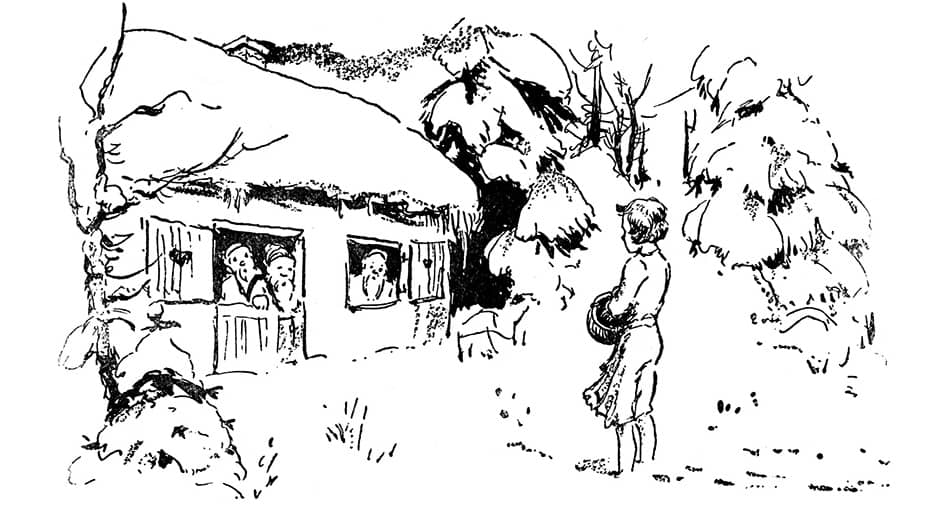
 Facebook
Facebook  Whatsapp
Whatsapp  Messenger
Messenger  Telegram
Telegram Reddit
Reddit















